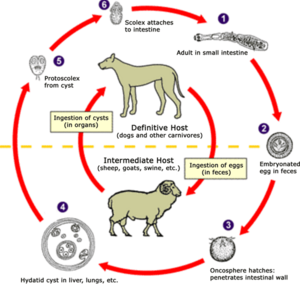Echinococcosis
| Echinococcosis | |
|---|---|
 |
|
| Echinococcus granulosa life cycle (click to enlarge) | |
| Classification and external resources | |
| Specialty | Infectious disease |
| ICD-10 | B67 |
| ICD-9-CM | 122.4, 122 |
| DiseasesDB | 4048 |
| eMedicine | med/629 med/1046 |
| Patient UK | Echinococcosis |
| MeSH | D004443 |
Echinococcosis, also called hydatid disease, hydatidosis, or echinococcal disease, is a parasitic disease of tapeworms of the Echinococcus type. The two main types of the disease are cystic echinococcosis and alveolar echinococcosis. Less common forms include polycystic echinococcosis and unicystic echinococcosis. The disease often starts without symptoms and this may last for years. The symptoms and signs that occur depend on the cyst's location and size. Alveolar disease usually begins in the liver but can spread to other parts of the body, such as the lungs or brain. When the liver is affected the person may have abdominal pain, weight loss, and turn slightly yellow from jaundice. Lung disease may cause pain in the chest, shortness of breath and coughing.
The disease is spread when food or water that contains the eggs of the parasite is eaten or by close contact with an infected animal. The eggs are released in the stool of meat-eating animals that are infected by the parasite. Commonly infected animals include dogs, foxes and wolves. For these animals to become infected they must eat the organs of an animal that contains the cysts such as sheep or rodents. The type of disease that occurs in people depends on the type of Echinococcus causing the infection. It is a type of worm infection and is a neglected tropical disease. Diagnosis is usually by ultrasound though computer tomography (CT) or magnetic resonance imaging (MRI) may also be used. Blood tests looking for antibodies against the parasite may be helpful as may biopsy.
Prevention of cystic disease is by treating dogs that may carry the disease and vaccination of sheep. Treatment is often difficult. The cystic disease may be drained through the skin, followed by medication. Sometimes this type of disease is just watched. The alveolar type often needs surgery followed by medications. The medication used is albendazole, which may be needed for years. The alveolar disease may result in death.
...
Wikipedia
